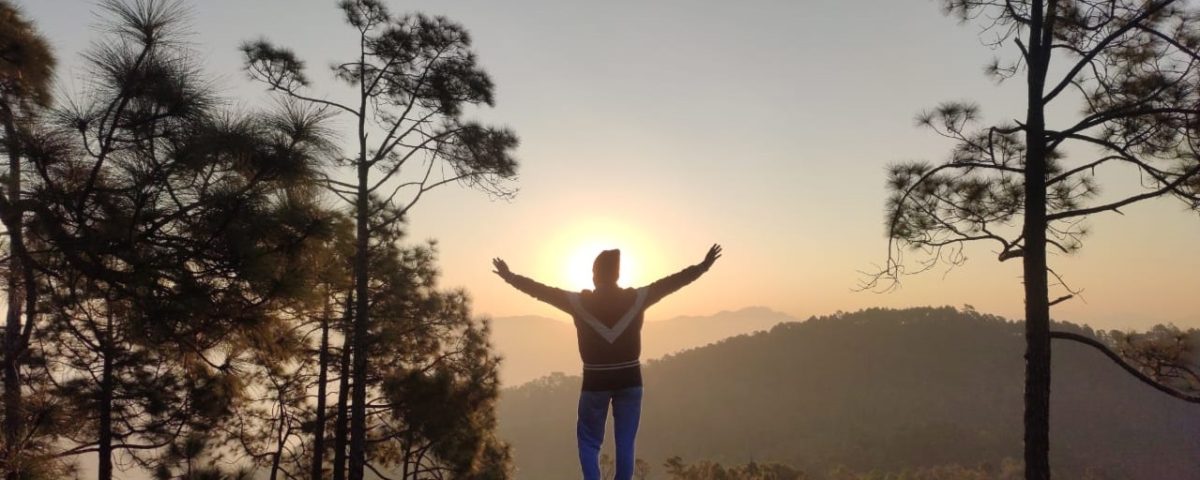
Renuka Vishwakarma : “How my ancestors contributed to the Asian history”
December 30, 2023
Anjali Karki : “Agriculture must be nature friendly”
February 14, 2024Chaukori : A story of Transformation, Challenges and Hope

Chaukori, circa 1970. The place evokes memories of picturesque tea gardens framed by middle Himalayan mountain ranges and distant snow peaks. Life revolved around a lone tea factory amidst these endless vistas of tea plantations.There were no transportation facilities except for a once-a-day bus, a sole means of travel even in the 1990s. The quietness of the place and its salubrious atmosphere attracted adventurous trekkers who sought solitude and communion with nature.
Garden of tea and tranquillity in the Himalayas
Sensing a potential for tourism, the government constructed a tourist rest house in a tea garden in the late 1970s. People living in the area at that time numbered a few dozen, who worked in the tea factory and the government run hotel. The peaceful environs of Choukori and its magnificent views of peaks like Nanda Devi and Panchchuli drew mainly nature lovers. The 1990s were watershed years when India embarked on a liberalised economy, a paradigm shift resulting in rapid industrialization and urbanization. The dawn of the 21st century transformed India. There are more roads and better communication facilities, and most importantly a large number of people were lifted out of poverty and the subsistence life.
With a booming economy and increased middle class spending on travel, the tourism industry has grown exponentially in the Himalayas. Realizing the importance of the industry for income generation for the rural population, the government encouraged the burgeoning tourist sector. There were many hotels and resorts built over the last 15 years that changed the character of many hill stations in the Himalayas.
During the same period ( 2005 onwards), the Himalayan public school expanded from offering primary education to also providing Intermediate level education. Now called Himalayan Inter College, the student population stands at 900 and there are about 100 teaching and non teaching staff. As it’s the institution catering to the educational needs of the area, in the absence of government run schools, many families migrated to Chaukori just for the sake of giving their children the best education. It’s difficult and also expensive to travel long distances in private vehicles on badly maintained roads. So the population of Chaukori registered a significant rise and new homes were built over this period. Sensing a business opportunity, a few corporate education conglomerates too moved in and established their schools.
From a tea estate to tourist hub
Once a sleepy hamlet with a tea factory as its heart, now Chaukori is abuzz with tourists and vacationers and the local population. Having seen its potential as a major tourist hub, the government encouraged home stay facilities to provide an “authentic” Himalayan experience to the visitors. And also the local economy could grow and provide income generation for the recently migrated population. However, there was no strategic planning as to how best to develop the place without disturbing the fragile nature and eco-systems.
The increased footprint of the tourists and local population has led to deforestation, water scarcity, sewerage problem and waste products from consumption. According to Prakash Karki, the manager of HIC, Himalayan Inter College, “It is the number one problem affecting the environment. The tourists and locals generate so much non-biodegradable waste that it’s impossible to dispose of without polluting the soil or contaminating the air. It’s important for people to use less plastic and polythene. Else the environment will be the first causality.”
Echoing these concerns, Laxica Bisht, a student of 12th class at HIC says, “the increasing number of tourists poses certain environmental challenges. However, it is possible to provide a meaningful and eco-friendly holiday experience to the tourists. We must encourage nature walks, bird watching sessions, controlled trekking, and farm-homestays designed with environmental concerns in mind.“
“There are some issues that go beyond tourists – local villagers too are contributing to deforestation and forest fires. It’s crucial for everyone to come together for a solution. I suggest implementing educational programs in schools to teach students nature advocacy that makes an impact on how the resources are managed. ” She further emphasises the need to establish Nature clubs in schools that would further enable students to initiate valuable projects such as community gardens, seminars on sustainable development, and documentaries about the local environment. “It’s important for students to be aware of the changing landscape of their villages and feel empowered to contribute positively.”
Balancing Development and Environment in the Himalayas
“This year is unusually warm and there was no snowfall till the end of January.” laments Raj Mahara, an arts teacher at HIC and a keen naturalist. “Usually we receive snowfall in the months of November or at least by December. But this year the mountains are devoid of their usual snow cover. With less snow, there is a danger of rivers carrying less water. And the downstream population in the plains of Northern India, who depend on the river water for agriculture and drinking, will be severely affected.”
“On our part, we must do something to make people aware of the environmental damage being made by the increasing human activity. As an artist, I want to create wall paintings along the streets of Chaukori and also in the vicinity of hotels, which will remind people to be environment friendly and maintain balance and harmony with nature.”
The changing landscape of Chaukori
Raj Mahara further adds, “Children must be made aware of the biodiversity of their place so that they appreciate and protect their rich natural environment. There must be regular classes implementing “nature curriculum” comprising indoor learning and outdoor activities.
HIC, leading by example, incorporates organic farming and solar engineering in their curriculum with an aim to inculcate “environment friendly” mindset among the students. Every week as part of the vocational education and training, they are taken to the fields and various farming techniques like vermiculture, compost making, pest control using natural compounds, soil conservation etc, are demonstrated. The school has a vegetable garden and fruit tree orchard, which are cultivated organically. Moreover, the students of HIC, as a part of the Clean and Green Chaukori campaign, regularly collect the trash left on the streets and dispose of it responsibly.
A decade ago, Himalayan Education Foundation (HEF) funded a project to set up solar panels for electricity generation for the HIC’s hostel. As the place gets really cold during winters, a solar heating plant was also installed by HEF to provide hot water for the hostel students. Students are now taught the concepts of alternative energy resources which don’t cause pollution and environmental damage.
Education and Action for sustainable Chaukori
HEF has been sponsoring the Kalasutra Festival, an annual event held in Munsiary. This fete celebrates the Nature and Culture of Kumaon region by organizing various events such as bird watching, Nature awareness marathon, screening of documentaries and talks by eminent conservationists. Groups of students from various schools in the Kumaon region attend this important event.
According to Raj Mahara, who regularly accompanies the students from HIC, it is important to sensitise the young and adult population about the pressing environmental issues. He would like an annual Nature Fair conducted in the Chaukori area also, where awareness programs are organized. People in and around Chaukori could attend this event and get to know the challenges to the natural environment and deliberate on what they could do locally to address these issues.
Human community thrives in a healthy environment. When it’s adversely affected, the lives of the people depending on it are seriously threatened. It’s time for all stakeholders to come together and take concerted and concrete actions so that places like Chaukori continue to retain their pristine character and yet create better conditions for human flourishing and happiness.



